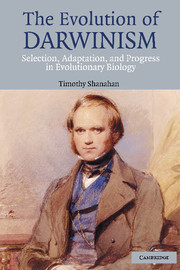Book contents
- Frontmatter
- Contents
- Introduction
- I SELECTION
- II ADAPTATION
- III PROGRESS
- 7 Darwin on Evolutionary Progress
- 8 Evolutionary Progress from Darwin to Dawkins
- 9 Is Evolution Progressive?
- 10 Human Physical and Mental Evolution
- Epilogue
- Appendix: What Did Darwin Really Believe About Evolutionary Progress?
- Notes
- References
- Index
10 - Human Physical and Mental Evolution
Published online by Cambridge University Press: 18 December 2009
- Frontmatter
- Contents
- Introduction
- I SELECTION
- II ADAPTATION
- III PROGRESS
- 7 Darwin on Evolutionary Progress
- 8 Evolutionary Progress from Darwin to Dawkins
- 9 Is Evolution Progressive?
- 10 Human Physical and Mental Evolution
- Epilogue
- Appendix: What Did Darwin Really Believe About Evolutionary Progress?
- Notes
- References
- Index
Summary
What a chance it has been … that has made a man.
(Darwin, “E Notebook p. 68; in Barrett et al. 1987, p. 415)Introduction
Recall once more Darwin's claim, the exploration of which is the central purpose of this book: “As natural selection works solely by and for the good of each being, all corporeal and mental endowments will tend to progress towards perfection” (Darwin 1859, p. 489; 1959, p. 758). In previous chapters we have examined the themes of “selection, perfection, and direction” as they pertain to living things in general, very few of which could be said to have impressive “mental endowments.” Natural selection in conjunction with various chance elements operates on a range of causally interconnected biological entities, resulting in striking evolutionary trends and astounding (but ultimately imperfectly designed) living things. Such is Darwinian orthodoxy, at least concerning the physical evolution of nonhuman living things. But what about human beings and their most distinctive characteristic – intelligence? What does (or might) Darwinism say about us? In particular, how might the evolution of intelligence figure in a Darwinian understanding of life?
In this chapter, we will look at the past, present, and future of Homo sapiens, as viewed through Darwinian perspectives, and in so doing connect the themes of selection, perfection, and direction in evolution as applied to our own species. A range of additional questions present themselves for our consideration. How did Darwin treat the evolution of human “corporeal and mental endowments”?
- Type
- Chapter
- Information
- The Evolution of DarwinismSelection, Adaptation and Progress in Evolutionary Biology, pp. 247 - 282Publisher: Cambridge University PressPrint publication year: 2004



